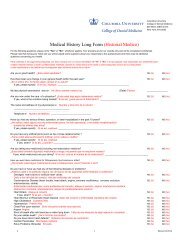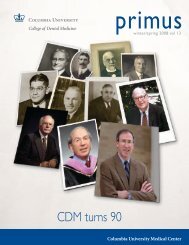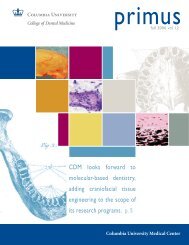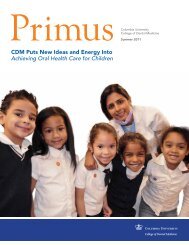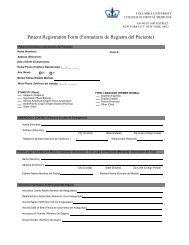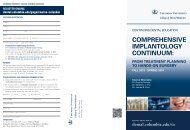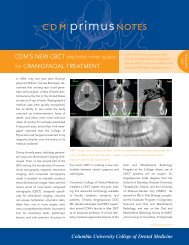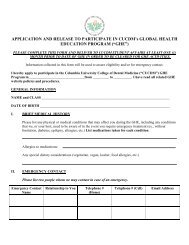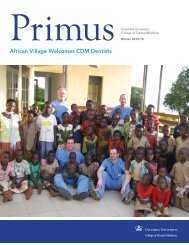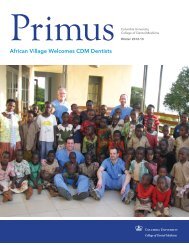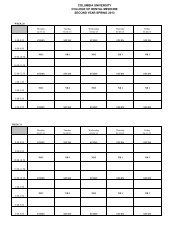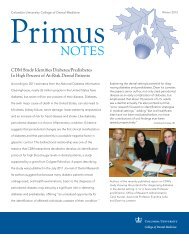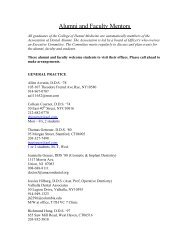Jarvie Journal - College of Dental Medicine - Columbia University
Jarvie Journal - College of Dental Medicine - Columbia University
Jarvie Journal - College of Dental Medicine - Columbia University
You also want an ePaper? Increase the reach of your titles
YUMPU automatically turns print PDFs into web optimized ePapers that Google loves.
Volume 56, Spring 2013<br />
Knowledge and Attitudes <strong>of</strong> <strong>Dental</strong> Students Towards Performing Research<br />
Joseph Wang, Carol Kunzel*<br />
<strong>College</strong> <strong>of</strong> <strong>Dental</strong> <strong>Medicine</strong>, <strong>Columbia</strong> <strong>University</strong>, NY, NY * Faculty Mentor<br />
Introduction: <strong>Columbia</strong> <strong>University</strong>’s <strong>College</strong> <strong>of</strong> <strong>Dental</strong> <strong>Medicine</strong> (CDM) maintains a robust research program. Yet many<br />
students, especially new students, may not be aware <strong>of</strong> how to become involved in dental research. A multitude <strong>of</strong> factors can<br />
play a role in a student’s decision to conduct research. In addition to factors <strong>of</strong> knowledge, a student’s attitude and perceived<br />
expectations may also influence the decision to perform research.<br />
Objective: 1) To learn more about the knowledge and attitudes <strong>of</strong> current CDM students towards involvement in research; 2)<br />
To identify the most influential variables in predicting involvement in a) research following dental school (MODEL 1), b)<br />
joining the <strong>Jarvie</strong> Society (MODEL 2), and c) contacting a faculty member regarding research opportunities (MODEL 3).<br />
Materials & Methods: Study subjects were 1 st -year CDM dental students (n=80). A total <strong>of</strong> 69 subjects participated (response<br />
rate = 86%). A 2-page paper questionnaire was developed to include questions and statements relating to: topics available in<br />
research, location and timing <strong>of</strong> research, the purpose <strong>of</strong> research, compliance awareness, sources <strong>of</strong> information, attitudes<br />
toward research, and website usability. Participants were asked to agree or disagree with each statement in the questionnaire,<br />
with responses ranging from 1 (strongly disagree) to 4 (strongly agree).<br />
Results: About 59% <strong>of</strong> the participating subjects reported that they had experience in prior research. When asked about what<br />
career they would like to pursue, 66.7% are considering specializing, 21.7% are considering GPR/AEGD, and 18.8% are<br />
considering academia. Using factor analysis, 7 groupings <strong>of</strong> variables were created: 1) knowledge <strong>of</strong> people in dental research,<br />
2) motivation by rewards and competition, 3) knowledge <strong>of</strong> locations to perform research, 4) knowledge <strong>of</strong> topics <strong>of</strong> dental<br />
research, 5) perceived importance <strong>of</strong> research, 6) positive perception <strong>of</strong> research, and 7) perceived expectations from others.<br />
Three predictive models were created in order to predict different intentions and behaviors <strong>of</strong> students, and all three models<br />
were regressed against these 7 variable groups.<br />
MODEL 1 focused on involvement with research following dental school (R 2 =.45). The two most influential predictors were<br />
positive perception <strong>of</strong> research (B=.33, p=.008) and perceived importance <strong>of</strong> research (B=.27, p=.045). MODEL 2 focused on<br />
whether students join the <strong>Jarvie</strong> Society, the dental student research club at CDM (R 2 =.52). The three most influential predictors<br />
were perceived importance <strong>of</strong> research (B=.30, p=.019), motivation by rewards and competition (B=.30, p=.022), and perceived<br />
expectations <strong>of</strong> others (B=.26, p=.025). MODEL 3 focused on whether students contacted a faculty member regarding research<br />
opportunities (R 2 =.56). The three most influential predictors were knowledge <strong>of</strong> people in dental research (B=.39, p



